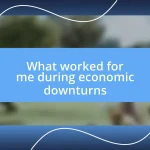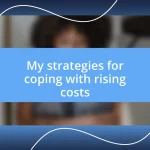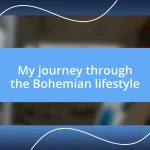Key takeaways:
- Visual storytelling transcends words, using imagery to convey emotions and narratives that resonate across cultures.
- Historical roots of visual storytelling highlight its long-standing importance in human communication, from ancient cave paintings to modern digital platforms.
- Emerging trends like VR/AR, user-generated content, and enhanced data visualization are shaping the future of how stories are told visually.

Understanding visual storytelling
Visual storytelling is a powerful way to communicate ideas and emotions through imagery, and it’s something I’ve grown to appreciate deeply over time. I remember the first time I watched a short film that relied heavily on visual elements rather than dialogue. The way a single shot of a sunset conveyed a character’s sense of longing resonated with me—it struck me that visuals can often express complex feelings words stumble over. Have you ever experienced a moment where an image just spoke to your soul, making you feel understood in an instant?
As I dove deeper into the realm of visual storytelling, I learned that it’s not just about the images themselves but how they weave together a narrative. I still recall a trip to an art gallery where a series of photographs told a harrowing story of resilience. The emotions captured in that series were palpable, leaving me contemplating the role of context. How do you think background and composition influence the story that an image tells? In my experience, they can transform an ordinary moment into something extraordinary.
Understanding visual storytelling is like unlocking a new language. Every element—the colors, the angles, the framing—carries meaning. I often find myself reflecting on how a well-captured moment can serve as a universal connector among diverse audiences. Then, I’m reminded of how a single photograph from a distant place can evoke a shared emotion within me and someone else from an entirely different background. Isn’t it fascinating how images can bridge gaps between cultures and experiences?

Historical context of visual storytelling
Visual storytelling has deep roots, tracing back to ancient civilizations where images played a crucial role in communication. I often think about the cave paintings of Lascaux, France, and how they vividly narrate stories of hunts and daily life. These early examples demonstrate that humans have always relied on visuals to convey experiences and emotions long before written language emerged.
- Ancient Egyptian hieroglyphs combined pictures and symbols to communicate complex ideas.
- The use of illuminated manuscripts in the Middle Ages showcased the power of visual narratives in religious texts.
- Renaissance painters transformed storytelling by blending art and narrative, making powerful emotional connections with viewers through composition and color.
When I first encountered these historical forms of visual storytelling, I felt a connection to the past. It was astonishing to realize that the instinct to tell stories visually is part of our shared human heritage. The emotions behind those ancient images resonate with me even today; they serve as a reminder that storytelling is universal. It evokes a sense of nostalgia, showing how far we’ve come and yet how fundamentally similar we remain in our need to share and understand our stories through visuals.

Tools for creating visual stories
When it comes to creating visual stories, various tools can elevate your storytelling game. I fondly remember the day I discovered Adobe Spark. It felt like an artist’s playground; combining videos, graphics, and text was relatively easy. The intuitive interface allowed me to focus on the narrative rather than getting bogged down in complexities. It’s fascinating how the right tools can spark creativity. Isn’t it amazing how accessible technology has made it for us to tell compelling stories visually?
Another remarkable tool I’ve come to appreciate is Canva, especially for its versatility. Initially, I used it for social media graphics, but soon realized its potential for storytelling. The pre-made templates offered a fantastic starting point, helping to shape my ideas into a cohesive visual narrative. I recall a project where I crafted an infographic to depict a journey I took. Every element—from colors to icons—told a part of my story, making it an engaging experience for my audience. Have you explored how design can amplify your message?
Lastly, I can’t overlook the power of storytelling platforms like Storybird. This tool allows users to create visually stunning stories by pairing images with text. I vividly remember using it for a personal project, where the illustrations resonated so deeply with my words that it felt like the pictures were telling half the story. I’ve always believed that combining visuals with narratives can evoke emotions in ways that words alone sometimes cannot. It left me wondering: how can we harness these tools to evoke deeper connections with our audience?
| Tool | Features |
|---|---|
| Adobe Spark | Video and graphic creation, user-friendly interface |
| Canva | Versatile templates, ideal for social media and infographics |
| Storybird | Visual storytelling platform, combines images with text |

Examples of successful visual storytelling
One striking example of successful visual storytelling is National Geographic’s Instagram presence. Their posts often combine breathtaking photography with compelling narratives about wildlife and cultures. I remember seeing an image of a polar bear with a poignant caption about climate change. It struck me, highlighting not just the beauty of the bear, but also the urgent message behind it. Have you ever felt that a single image can convey a story that words alone fail to capture?
Another example that resonates deeply with me is the animated short films produced by Pixar. Take “Up,” for instance; it opens with a beautiful montage of Carl and Ellie’s lives together, vividly illustrating their dreams and love without a single line of dialogue. That sequence makes my heart swell every time I see it. I can’t help but ponder: how does a story immerse you so profoundly with such simple visuals and music?
Finally, I find infographics, particularly those shared by organizations like the World Health Organization, to be powerful tools for visual storytelling. I distinctly recall reading one about the impact of vaccination on public health. Each chart and illustration told a story that was easy to follow and understand, yet packed with important data. It drove home the significance of the topic in a way that raw numbers alone would not. Don’t you think these visual narratives can change perceptions and drive action in society?

Challenges in visual storytelling
Visual storytelling can be immensely rewarding, but it’s not without its challenges. One of the biggest hurdles I’ve faced is finding the right balance between visuals and text. I recall a moment when I created a vibrant slideshow for a presentation, only to realize later that my audience was too focused on the images to absorb my key points. It made me reflect: how do we ensure that visuals enhance the story rather than overshadow it?
Another challenge lies in engaging the audience emotionally. During a project where I aimed to tell a personal story through imagery, I discovered that not every picture struck the right chord. I had a heartfelt snapshot, but the accompanying visuals failed to convey the emotion I intended. This led me to ask myself: how can we capture authentic emotions visually, ensuring our audience truly connects with our narratives?
Technical limitations can also pose significant challenges in visual storytelling. I remember trying to incorporate interactive elements into a project, only to be stymied by software restrictions. This experience taught me that technology should serve our creativity, not hinder it. It begs the question: how do we adapt our storytelling strategies when faced with such limitations? Finding workarounds can make a difference, but it often requires creative thinking and flexibility.

Future trends in visual storytelling
As visual storytelling continues to evolve, I see an exciting trend emerging: the integration of virtual and augmented reality (VR and AR). Just imagine the impact of immersing an audience in a 360-degree narrative where they can explore every corner of a story. I recall experimenting with a VR platform during a workshop, and it really opened my eyes to how powerful it can be when users can not only see but also feel a part of the story. Have you ever considered how much more engaging it might be to step into someone else’s shoes and experience their journey firsthand?
Another trend I’ve noticed is the rise of user-generated content. Brands are increasingly tapping into the creativity of their audience, encouraging them to share their stories through visual mediums. It reminds me of a campaign I participated in, where we shared our unique experiences with a product through Instagram stories. Knowing that our real-life narratives could influence others was both exhilarating and intimate. How does it feel to become not just a spectator but a co-creator in someone else’s story?
Lastly, data visualization is shifting from mere representation of facts to a more engaging narrative form. I vividly recall a presentation where a complex dataset was transformed into a dynamic, animated story, illustrating trends over time. It made the statistics not only digestible but also compelling. Isn’t it fascinating how numbers can weave a narrative that resonates deeply, making abstract concepts tangible and memorable?














